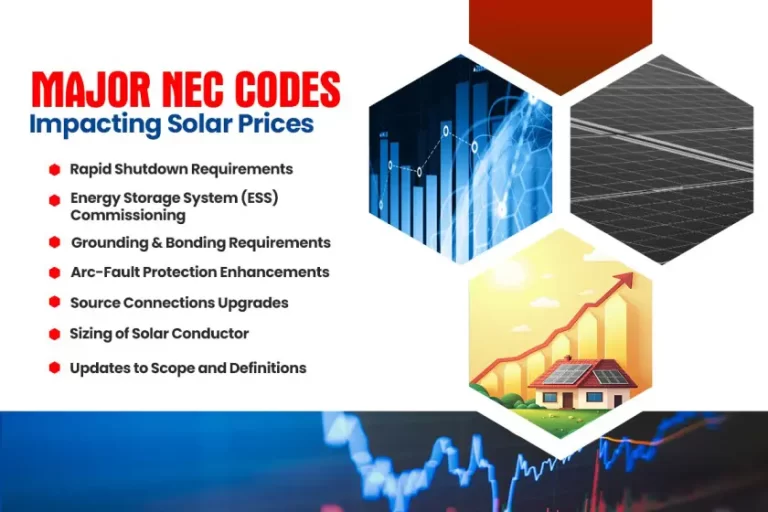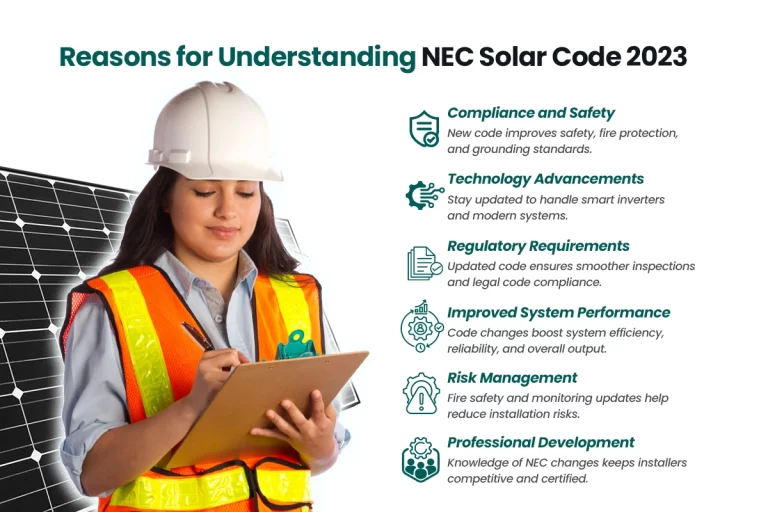- Published On:
NEC Solar Code 2023 & Local AHJ Codes: Enhancing Solar Safety at a Cost
The NEC solar code specified benchmarks for a solar panel system’s safety and performance and every solar installer must meet these standards to pass inspection. The Solar Code 2023 reflects the updates about modifications and improvements in a solar system and installation process for increased safety, technology advancement and maximum solar output. These standards require changes in solar battery storage testing, grounding techniques, system designing, rapid shutdown etc.
Additionally, the Authorities Having Jurisdiction (AHJs) is already enforcing regional and national requirements of codes to make sure that all solar installations must meet the quality standards. Although these updates are aiming to increase the solar safety level, it may lead to high solar installation costs. The modern technology, high quality equipment, updated documentation and system testing, they all incur additional cost. On the other hand, it is mandatory to solar installation companies to meet all the standards for inspection and permit approvals.

What is the NEC solar code and why is it important for the solar energy industry?
The National Electrical Code (NEC) is published by the National Fire Protection Association (NFPA) every three years. This association sets benchmarks for solar panel system design, solar equipment, installation criteria, site inspections and energy storage. The objective of these standard settings is to ensure safety from any kind of electrical danger or solar panel fires. With some statewide changes, this solar code is recognized around the United States. This code addresses all the safety requirements in a solar energy system including wiring, grounding, rapid system shutdown and battery storage testing. To pass solar inspections, the installer must meet all the specifications of NEC code 2023.
The NEC’s 2023 version includes several updates that specifically target solar and solar-plus-storage systems. This code system reflects the safety importance concerns due to rapid adoption of rooftop and commercial solar. Also, larger solar systems, new solar technologies, and a competition in the solar market demands for strict safety standards to make it beneficial for solar owners to invest in solar energy.
What are the major NEC 2023 codes impacting solar installation costs?
We will discuss some important National Electrical Code requirements that may lead to higher costs of solar installations in the United States.

Rapid Shutdown Requirements:
These requirements were added to the NEC in the 2014 code cycle. The purpose was to ensure firefighter’s safety from electric shocks in case of solar panel fires. Also, these codes lead to a safe solar panel system for solar owners.
Module-level power electronics (MLPE) are used by many PV installers to satisfy the Code’s rapid shutdown criteria. MLPE devices are usually wired directly to the PV modules and mounted directly to the same racking system that holds the modules. These gadgets could be inverters or converters from DC to AC. MLPE can manage the voltage on their circuits through a quick shutdown start. Some manufacturers are using UL 3741, a newly published UL standard. This provides testing methods to solar manufacturers to demonstrate that their products offer firefighters safety and effective shock protection. New array configurations, inverter placement strategies, and the reduction or potential elimination of the requirement for MLPE devices within the array while still satisfying code requirements are all results of this new standard and its implementation on the rooftop.
The solar installers need to install MLPEs like high quality solar microinverter or DC optimizers in each panel to fulfill the NEC requirement. Although, this improves the rooftop solar’s safety but it will increase material cost and installation lead time. Also, technicians require special training for handling system’s complexities.
Energy Storage System (ESS) Commissioning:
For solar battery storage system, there are also new benchmarks in the NEC solar code 2023. The requirements include new criteria for testing solar batteries after the installation process. The code highlights specific protocols that an energy storage system must meet to get approval. Also, for analyzing battery performance and safety, the strict process is added in code. To meet ESS specifications by solar code, it requires specialized equipment like UL 9540-approved battery enclosures, fire-suppression units built into designs, and temperature control functionality. All these improvements increase materials and design costs. Moreover, electrical engineers then have to design storage plans for each project which also may increase the solar installation cost.
Grounding & Bonding Requirements:
The 2023 NEC solar code refines requirements for safety and compliance of solar installations by introducing significant revisions to grounding and bonding requirements in Articles 250 and 690.43. These adjustments are vital for larger, higher-amperage PV systems. These updates demand a more specific process to install and ground a PV system and other solar equipment for reducing the risk of electrical faults and solar energy system’s safety. The best strategies for choosing right size conductors and other bonding materials are also specified in the NEC solar code 2023.
It requires large gauge conductors, corrosion-resistant material, and additional bonding materials to meet the code requirements. Also, grounding lugs, busbars, and bonding jumpers all have incremental costs, and accurate placement adds additional design and labor verification, adding to higher inspection and labor costs.
Protection Improvements for Arc-Fault:
For Arc-Fault safety, NEC solar code highlights essential improvements. The association specified an updated standard for the Arc fault circuits in a solar panel system. This will increase the safety of PV systems and reduce the risk of solar panel fires. The solar installers must follow all the NEC requirements to get approval.
However, to fulfill the code requirements, solar panel companies need high quality string inverters and specialized AFCI devices that may increase the cost of solar system. Moreover, additional wiring and maintenance tests may also add operating costs.
Upgrading of Source Connections:
The new solar code 2023 also includes updated requirements for source connections like splices and tapes. It is strictly required to follow all the specifications like use of proper tools and techniques to ensure the safety and reliability of a solar installation.
According to NEC updates, the installers must use high-quality equipment and materials, branded connectors and top-notch installation techniques to meet the code requirements. This may lead to a longer install process, technicians’ training and more inspections. These measures will enhance the safety level of a solar panels system but also increase the labor and material costs for the larger systems specifically which requires multiple service connections.
Sizing of Solar Conductor:
For the increasing voltage and current requirements of modern PV systems, the 2023 NEC solar code introduces significant changes to solar conductor sizing and protection. To guarantee system performance and safety, these improvements require close consideration of conductor ampacity, temperature ratings, and overcurrent protection. For large-scale or commercial PV systems, updated conductor sizing standards affect voltage drop estimates, grounding methods, and NEC solar code for solar installation compliance. Conductors of the right size reduce the risk of overheating, increase efficiency, and satisfy the most recent NEC solar insulation and derating regulations.
According to the 2023 NEC solar code, the solar installation cost will increase with changes in conductor size. The solar companies need to use top-rated conductors to fulfill the updated temperature requirements of the code. However, this high-quality conductor comes at a high cost so the overall solar installation expense will also rise. Also, it may require some extra parts and complex system design to meet the voltage drop limits and overcurrent flow protection mentioned in the code requirements.
Scope and Terminology Updates:
The definition and regulation of solar installations are altered in the 2023 NEC solar code. The way solar terminology is used in system design and permitting is affected by these modifications. The elimination of multiple definitions is a significant modification. This change requires modifications to solar paperwork and compliance procedures since it standardizes the way electrical terminologies used throughout the NEC code for solar installation.
The 2023 NEC revisions to Scope and Definitions will make solar installations costly due to the added expense of revised documentation and processes. The alteration of definitions requires installers to rework on designing documents, plans and permits to fulfill the new demands. This can lead to more time and training for staff to familiarize themselves with the new terminology, and possibly higher consultation cost for code or legal professionals. It will increase the cost of a solar project as labor and operational expenses increase.
Why does NEC Solar Code 2023 matter?
To maintain compliance, safety, and efficiency in PV system installations, solar installers need to stay up to date with the 2023 NEC solar code. Here are the top reasons:

Concluding, all NEC solar code 2023 requirements reflect to make a more efficient, reliable and safe solar panel system which ensures peace of mind for a customer. However, these improvements require technological advancements, high quality materials, new equipment, changes in solar design and installation process which may all incur additional cost for not only homeowners but solar installers too.
Solar companies need to work smart to meet all the NEC code requirements and provide their clients with a safe PV system. On the other hand, the potential solar owners should also understand that investing in solar power brings many benefits, including low energy bills and grid independence but safety is a major element. Using cheap or low-quality materials for solar installation may risk your life for saving some mone,y which you can get again with solar savings. Also, with federal solar tax credit and best solar rebates, potential owners can still cut upfront costs with a safer solar energy system installation.
Solar SME is a certified solar installer near you for top-tier solar solutions at affordable costs. We always priortize NEC solar codes throughout the solar installation process and ensure a safe residential or commercial solar system for our customer’s peace of mind. We are proud to partnered with top solar brands for high-quality solar panels and accessories and also utilize modern technologies for installing solar. So, if you want to reap all solar benefits with a safe solar panel system, get a FREE Quote of estimated savings with our smart solar calculator now!
Related Articles:
One of America’s most effective solar incentives is net metering. It has driven the growth of residential solar with laws in over 40 states and U.S. territories.
30% federal tax credit is expiring in 2025. But if you missed out on it, you can still access solar power with Solar Lease/PPA financing. This option is an opportunity to get all the advantages of solar power while making no large initial investments. Explore More!
Solar panel cost is the key consideration. Learn how to make your solar journey more affordable even in the new solar tariffs era with best solar incentives and rebate programs!



